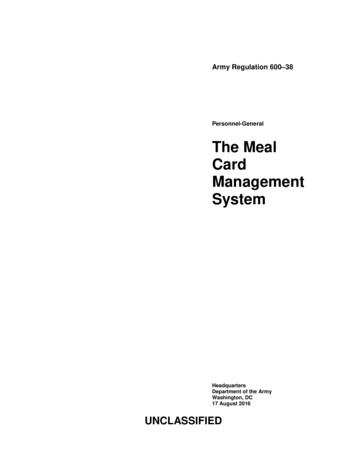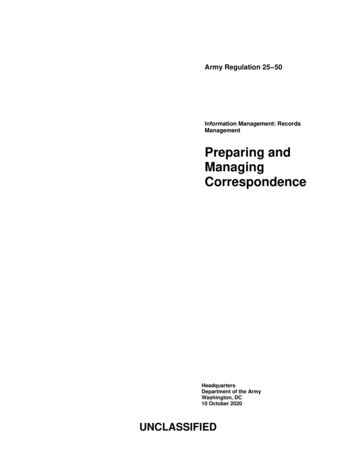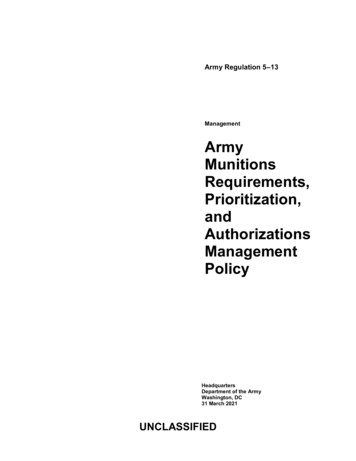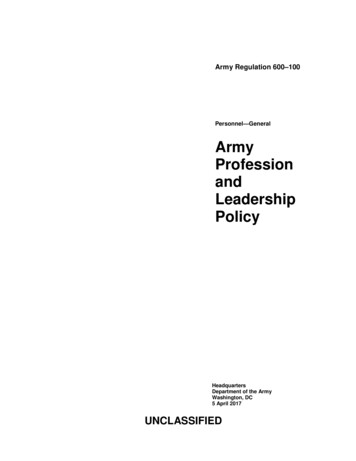
Transcription
CENTER FOR ARMY LESSONS LEARNEDCALL INSIDERJAN-FEB 2018Recent CALL PublicationsDirector’s CornerOne of my primary goals as CALLDirector has been to increase thenumber of After Action Reports(AARs) we take in from thefield and thereby increase theinformation sharing back to theforce. We are trying to make thiseasier to do by adding a newAAR “upload” button on the frontpage of the CAC-enabled CALLwebsite. By accessing this link,individuals and units charged withpreparing an AAR can not onlysubmit reports, but also find useful resources such as therecommended format, sample AARs, and archived reports.We are always open to new ideas, so tell us how we canmake this process better!Part of being a learning organization is assessing events andsituations and then making needed changes to overcomedeficiencies or improve performance. The after actionreview is a routine process, a part of the Army culture at theunit level. We do this well with our tactical units, adjustingtraining, updating SOPs, increasing understanding, alwayslearning and growing even as personnel turnover occurs.How does the Army as an institution learn, grow, and fixproblems that are identified in operational units? The answeris the After Action Report. Not just doing these reports, butgetting them into the Army archive, the long-term memory.An individual report sent to the right person can impact aspecific discrete problem. The true power of archiving ourreports in a central database is the identification of lessobvious but consistent problems that can be identified whenanalyzing multiple reports over time.This is how the institution can learn better, but that learningcan only happen if the information exists and is accessible.In the future, artificial intelligence has the potential to do thisanalysis more quickly and with greater depth; however, anyanalysis, human or machine conducted, is only as good theinformation available.Mike PappalCOL, ARBrigade Sustainment inDecisive Action OperationsProviding sustainment in a decisiveaction environment is extremelychallenging, but these observationsand best practices from OperationsGroup, National Training Center,should help units in synchronizingthe sustainment plan with thescheme of maneuver and indeveloping home station training thataddresses observer-coach/trainer (OC/T) observations.“When sustainment operations are not synchronized ormanaged, they limit the commander’s options and freedomof movement.” JLLIS link.Deployment ReadinessExercise Lessons and BestPractices (CAC login required)In a “fight tonight” scenario involvingmultipleStrykerandArmorBrigade Combat Teams deployingsimultaneously against an aggressivepeer opponent, there will not betime to “just figure it out.” The abilityto rapidly deploy equipment andpersonnel from home station to an area of potential conflictis critical. Leaders at all echelons should take the lessonsand recommendations in this publication and conduct anassessment of their own installation’s current state. JLLISlink.Saber Guardian 17 Post Exercise Report (CAClogin required)This report provides a summary of key observations, insights,lessons, and best practices collected by a 19-memberCALL-led multi-organizational collection and analysis team(CAAT) during Exercise Saber Guardian 17 (SG-17). SG17 and associated exercises were conducted between6-22 JUL 2017 at various locations throughout Hungary,Romania, and Bulgaria. SG-17 consisted of a commandpost exercise (CPX)/computer assisted exercise (CAX), anair defense artillery live fire exercise (ADA LFX); LFXs, fieldtraining exercises (FTX); several wet gap crossings and amass casualty exercise (MASCAL). JLLIS link.Approved for Public ReleaseDistribution Unlimited1
CALL INSIDERJAN-FEB 2018News From the Front and CTCsATTACK! Insights and Issues with the BCTOffense in DATE (CAC login required)The senior OC/Ts and their respective divisions compiled thislist of planning and execution issues in offensive operationsin the Decisive Action Training Environment (DATE) at theJoint Readiness Training Center (JRTC). It is a review of themost common offensive operations and attack planning atthe JRTC. This list is not all inclusive, nor is it a restatementof JRTC trends for the past couple of years — althoughmany of these same issues do pop up in the trends.This listlooks specifically at the offense, and in some case narrowly,at particular operations within a larger offense. JLLIS link.Infantry and Engineer Combined Operationsin the DATE (CAC login required)This article is intended for all units conducting home stationtraining to prepare themselves for a combat training center(CTC) rotation. The author discusses a recurring trendthat many infantry units from company-level up to brigadecombat team (BCT) failed to integrate their engineers earlyin the planning process. JLLIS link.The Brigade Engineer Battalion Role at theJoint Readiness Training Center (CAC loginrequired)The author finds the brigade engineer battalion (BEB)consistently conducting additional tasks beyond its functionalrole to provide engineer coordination for combined armsmaneuver, countermobility and survivability, as well asthe requisite military intelligence, signal, and chemicalreconnaissance support to the BCT. In a sense, the term“brigade enabler battalion” seems to apply, especially whenthe BCT commander relies on the BEB to serve as hismission command “problem solver.” JLLIS link.Preparing the Brigade Engineer Battalion forthe Joint Readiness Training Center (CAC loginrequired)As the BEB prepares to deploy to the JRTC, a few pointsmust be emphasized to ensure the organization as a wholeis properly prepared to operate in the DATE. The authordiscusses a recurring trend during each Leader TrainingProgram (LTP). Task Force 5 briefs the BEB, focusing onbattle command and staff planning, coordination, integration,synchronization, and execution of BEB-specific combatoperations in the DATE. Since LTP usually occurs one tothree months prior to a unit’s JRTC rotation, it is usuallytoo late to affect common training shortfalls and trendobservations. JLLIS link.CALL INSIDERDigits? We Don’t Need No Stinking Digits!How G-Man Wins with Pure MissionCommand (CAC login required)Mission command is not a single piece of gear, nor is it asystem of interconnected systems. Mission command is aphilosophy of command built on the platform of commander’sintent. The opposition force (OPFOR) or “G-Man” focuses onthis philosophy to exercise mission command as defined indoctrine as “the related tasks and systems that develop andintegrate those activities enabling a commander to balancethe art of command and the science of control in order tointegrate the other warfighting functions.” G-Man adds a keyingredient to that definition using another even older militaryprinciple: Keep It Simple, Stupid or KISS. JLLIS link.Where Did I Put That? KnowledgeManagement at Company and BattalionIn this article, the author discusses the challenge rotationalunits face in debating the use of analog versus digitalproducts. While each method has its own merits, eachpresents its own challenges as it relates to knowledgemanagement (KM). Thus, each method should haveassociated techniques for ensuring effective knowledge flowto higher, subordinate, and adjacent headquarters. JLLISlink.Saving 30% More: Lowering Died ofWound Rates in a Decisive Action TrainingEnvironment (CAC login required)The author discusses how can a unit can significantlyreduce the died of wounds rate if personnel effectivelyincorporate Army Health System Support into brigade andbattalion-level planning, operationalize the plan throughdeliberate resourcing and rehearsals, and execute the planin accordance with tactical combat casualty care. JLLIS link.Deliberate Aeromedical EvacuationEmployment in Support of Decisive Action(CAC login required)The author discusses a recurring trend at the JRTC thatArmy aeromedical evacuation (AE) is not a “one size fitsall” model. AEs must be incorporated into the health servicesupport plan and need to be built and developed based onthe current mission and associated mission variables. JLLISlink.The Challenges of Providing RelevantAdvisor TrainingThe author discusses some of the challenges that theSecurity Force Assistance (SFA) Academy faces as oneof the staple courses of the 3rd Battalion, 353rd ArmorRegiment, for preparing future advisors. The goal of theacademy is to teach the two categories of individual advisingskills: enabling skills and developing skills. JLLIS link.Approved for Public ReleaseDistribution Unlimited2
CALL INSIDERJAN-FEB 2018Recent After Action ReportsOperation Saber Focus Final Report (CAC loginrequired)Report from 1-6 Aviation Reconnaissance Squadron (ARS)and 601st Aviation Support Battalion (ASB), 1st CombatAviation Brigade (1CAB), CPX held 1-6 OCT 2016 at the FortRiley Mission Training Center, the mock airfield, and the 1stInfantry Division (ID) training area in order to validate thesquadron’s ability to execute its near wartime mission.Final Report of 1st Air Cavalry BrigadeExpeditionary Deployment ISO AtlanticResolve (CAC login required)Now, more than ever, U.S. Army aviation assets are in highdemand as part of the U.S. Army’s dynamic presence inU.S. Army Europe (USAREUR). Building a “Strong Europe,”through regionally aligned forces (RAF) in a highly energizedenvironment presents complex challenges for CABstransitioning from their home station into the Europeantheater. This paper assesses the different aviation-specificconsiderations and requirements necessary to achievesuccess during reception, staging, onward movement, andintegration.3/2 CR Summer Shield 16 (CAC login required)3rd Squadron, 2nd Cavalry Regiment had the opportunity toparticipate in Summer Shield 2015 and 2016. Participation inconsecutive exercises allowed the squadron’s leadership toobserve the exercise’s progression to meet not just fires andmission command training objectives, but also to incorporatesustainment, intelligence and movement and maneuver.Lessons Learned from Task Force BlackFalcon (CAC login required)Provided are two lessons learned/after action report (AAR)white papers provided by Task Force (TF) Black Falconwhich capture major observations and recommendationsfrom the battalion and fire direction center perspectives. Bothdocuments are highly recommended as “must-read” for firesunits deploying in advise and assist roles. There are lessonsand best practices on sustainment, counter-fire, targeting,precision munitions, and five requirements for accurate fire,from an advise and assist perspective.82nd Airborne Division Artillery LessonsLearned during Exercise Dynamic Front II(CAC login required)Exercise Dynamic Front II encompassed a week-long CPXthat featured a near-peer, hybrid enemy force. The 82ndAirborne Division artillery, as primary training audience,served as a Force Field Artillery Headquarters for the 4thInfantry Division (simulated) under the NATO Allied RapidReaction Corps.2/101 Mission Command AAR (CAC loginrequired)2nd BCT, 101st Airborne Division, provides feedback onthe types of systems and processes used following fieldingof Capability Set (CS)-15, its use during a unified landoperation/decisive action JRTC rotation, and the subsequentdeployment in support of Operation Inherent Resolve in Iraq.These recommendations are specific to those experiencesand are to inform future similar efforts.News You Can UseJMRC Quarterly Newsletter (CAC login required)This edition features lessons that apply to organizations atthe BCT, battalion, and company level. This issue focusesspecifically on interoperability topics and Joint MultinationalReadiness Center (JMRC) OPFOR tactics, techniques,and procedures (TTP). These newsletters are designed tobe useful and contribute to your unit’s leader developmentprogram and preparation for CTC rotations. The nextnewsletter will be published in April 2018 and will includelessons learned from Allied Spirit VII and VIII rotations.DLA Center for Lessons Learned Update (CAClogin required)This issue contains Joint Lessons Learned InformationSystem (JLLIS) tips for Defense Logistics Agency (DLA)users and an update from the DLA Rapid Deployment Teamthat spent five weeks in Puerto Rico orchestrating criticalsupport to victims of Hurricane Maria.CALL INSIDERJoint Lessons Learned Program Update (CAClogin required)DD J-7 has deliberately implemented a scaled-down formatto focus on content, deliver information more responsively,and simplify dissemination. The hope is that a simplifiedformat will prompt users to more broadly disseminate thisnewsletter. Wherever appropriate, points of contact andlinks to the lessons-based content are provided for easieraccess.CALL Warehouse MoveThe CALL publications warehouse has closed on FortLeavenworth and online orders will now ship from the ArmyTraining Support Center at Fort Eustis, VA (the link for ordersremains unchanged). During the transition, mail orders willbe delayed, but we expect normal service to resume on orabout 12 March. Publications can still be downloaded andaccessed at https://call2.army.mil (CAC login required).Approved for Public ReleaseDistribution Unlimited3
CALL INSIDERJAN-FEB 2018Coming SoonBest Practice SubmissionsCold Hit Live Fires - Building Confidence andTrust in Leaders (CAC login required)CTC Trends FY17Infantry assaulting an objective, sight unseen with livemunitions and combined arms support, is as close tocombat conditions that we can replicate. This 1-27 InfantryBattalion white paper discusses how the unit developed andconducted cold hit live fire exercises to promote and sustainreadiness at peak levels.This bulletin will outline trends for fiscal year (FY) 2017across the CTCs, based on observations from OC/Ts andcollection and analysis teams from CALL, with support fromvarious Army Centers of Excellence. Organized by Armytactical tasks from the Army Universal Task List, these trendsreflect both positive performance (sustains) and areas thatneed emphasis (improves). CTC trends provide valuableinformation to units developing and executing training fordeployment to a CTC or an operational environment.required)The evolving threat of facing a near-peer adversary in aconventional fight necessitates a shift in mindset in how aBCT organizes and employs the Shadow Tactical UnmannedAircraft Systems (TUAS) platoon. In a DA fight, the TUASplatoon must be prepared to conduct a dynamic missionset from concealed tactical assembly areas (TAAs) with colocated hasty landing strips to launch and recover aircraft.The purpose of this paper is to share relevant experiencesof the 588th BEB Shadow Platoon at JMRC, discuss thechallenges of operating the Shadow platform from a hastylaunch and recovery site, and make recommendations onimproving Shadow TTP in a decisive action environment.Mission Command Training Program’s (MCTP) keyobservations express the impressions collected by MCTPOC/Ts during training exercises throughout FY 2017. Theinformation in this bulletin will comprise the most recentand salient points distilled from multi-echelon, multicomponent mission command training exercises conductedin the decisive action training environment. This bulletin isdesigned to increase readiness by serving as a resourcefor commands and staffs to use in home station training,whether in preparation for a MCTP exercise or an operationalmission.A Critical Review of TUAS Operations at theJoint Multinational Training Center (CAC loginContingency Operating Site WarriorReligious Support Team Actions duringMASCAL (CAC login required)This memorandum for record outlines the actions takenby the contingency operating site (COS) Warrior ReligiousSupport Team during a MASCAL event that occurred in Iraqin September 2011.Data CallOperating in a Denied, Degraded, DisruptedSpace Operational Environment HandbookThe space domain is a vital component of the emergingconcept of multi-domain battle and the warfighter is relianton the capabilities it provides to be successful in executingoperations. This collaboratively-produced handbook willgive the warfighter techniques and strategies to successfullyoperate in a denied, degraded, disrupted space operationalenvironment (D3SOE).JAGIC InsightsDo you use job books in your unit? During collection activities,units are asking CALL personnel for information on this topic.If you have an example of one that you find helpful and wouldlike to share with other units, please submit it to the CALLbest practice page. (CAC login required)Are you Registered for the LessonsLearned Workshop?This handbook will serve as a companion piece to 2017’sCALL Handbook Joint Air Ground Integration Center(JAGIC). It will provide additional JAGIC-related insights,lessons, and best practices from mobile training team (MTT)visits, Warfighter exercises, and other training events led bythe Army Joint Support Team teamed with U.S. Air ForceAir Combat Command, and the Fires Center of Excellencesubject matter experts.Transition to a JFHQCALL will host the FY19 Army Lessons LearnedSynchronization Workshop (ALLSWS) 27-28 MAR 2018at the Frontier Conference Center, Fort Leavenworth, KS.This annual event consolidates and endorses topics todrive Army collection, analysis, and product developmentfor the upcoming fiscal year. For more information, orto register, go to al/SitePages/Home.aspx (CAC loginrequired).CALL INSIDERMCTP Key Observations FY17This upcoming handbook leverages CALL collections inactive joint operation areas and joint exercises to providecommanders and staffs at echelons above brigade (EAB)with a guide to transitioning to a joint force headquarters. Asthe Army faces the threats of today and the future in a dynamicand competitive operational environment, commanders andstaffs of a theater army, corps, and division must be preparedto rapidly transition to a joint force headquarters (JFHQ) andeffectively operate across the range of military operations.This handbook will complement the recently publishedArmy Training Circular 6-6, Training the Mission CommandWarfighting Function: Transitioning to a Joint Headquarters.Approved for Public ReleaseDistribution Unlimited4
CALL INSIDERJAN-FEB 2018Combat Training CentersJoint Multinational Readiness CenterNational Training CenterThe JMRC continues to emphasize multinationalinteroperability, which in Allied Joint Doctrine is definedas “the ability of the forces to operate together coherently,effectively, and efficiently” in three key domains: human,procedural, and technical. As a tactical center of excellencefor multinational interoperability, JMRC is committed toimproving our ability to fight tonight with our Allies andPartners while continuing to see gains in U.S. formations’readiness.The National Training Center (NTC) continues to conducttough realistic, unified land operations with our unified actionpartners. A few observations from recent rotations includeplanning for organic intelligence collection (IC) assets,effective employment of aviation LNOs, and graphicsdistribution. BCTs at the NTC often focus their IC planning efforts onEAB assets provided by division, leaving their organicassets with minimal guidance. As a result, collectionusually does not answer the BCT commander’s priorityinformation requirements (PIRs). The BCT operationsand intelligence staff, along with the BEB and militaryintelligence company leadership must develop soundcollection plans for organic assets first, to ensure theyhave guidance to execute their mission, and that supportunits understand their role in the collection mission, andthen close any existing gaps with EAB assets. Observations of the brigade and division commandposts show aviation liaisons are identified late, givenlittle guidance, and given no reporting structure fromtheir organic unit. Operating in a decisive actionenvironment, with a large volume of informationpassing through each command post, an aviation LNOis uniquely positioned to ease planning efforts andensure aircraft are employed in accordance with theaviation task force commander’s intent. LNOs shouldbe empowered by their aviation command, and comeprepared with aviation estimates, aircraft capabilities,PIR, commander’s critical information requirements(CCIRs), maps, crew duty cycles, and their own meansof communication. Intelligence sections often struggle to distributeanalog graphics to the company level. Currently, mostintelligence sections produce hand-drawn overlays onlarge maps and then hand-copy the graphics on acetate.This method is time consuming and lacks the necessaryaccuracy. The Multi-Function Workstation (MFWS) is aprogram that exists on the Distributed Common GroundSystem Army (DCGS-A) in which analysts can createhighly accurate icons and graphic control measuresthat are geo-rectified with this program. Once theseelements are templated in MFWS, the analyst can turnoff the mapping layer, leaving gridlines and any elementsthat need to be produced on an overlay. At this point, theanalyst can print an overlay by placing clear overheadprojector sheets into a traditional LaserJet printer whichcan be placed on any map of the same scale.Best Practice — Mission Command — Fundamentalsfor Interoperability Success:The five fundamentals for interoperability success provideprinciples for overcoming procedural, technical, and humanincompatibilities in multinational units.1. Liaison Packages, Not Just Liaison Officers.The exchange of liaison officer (LNO) packages is theprimary and most effective method units employ toenhance multinational interoperability. Units must identifyinteroperability gaps or vulnerabilities and then selectindividuals and equipment with the correct tactical andtechnical capabilities to facilitate mission command andother mission critical functions. To effectively enhancecooperation, understanding, coordination, and unity ofeffort, liaison packages must be trained to represent thecommand in conveying the commander’s intent, guidance,mission, and concept of the operations.2. Understand Capabilities and Limitations. Developingshared understanding of capabilities and limitations acrossmultinational units not only improves tactical employment,but also highlights opportunity and exposes risk.3. Face-to-Face Mission Preparation for SharedUnderstanding. During mission preparation processesand transitions between missions, commanders and staffsrequire face-to-face touch points and simplification of themission orders process to ensure plans are feasible, andorders are received and understood.4. Critical Standard Operating Procedures (SOPs).Develop, implement, and deliberately rehearse at a minimumSOPs, using NATO Standardization Agreements and AlliedJoint Publications as a baseline, for fratricide avoidance(vehicle marking, near and far recognition, adjacent unitcoordination), forward and rear passage of lines, reporting,call for fire, and medical evacuation procedures.5. Complete Common Operational Picture (COP). Aneffective COP starts with consolidated, shared operationalgraphics and relies on timely and accurate subordinateunit reporting in accordance with the primary, alternate,contingency, and emergency (PACE) plan. It is alsosupported by effective communication systems that reducethe miscommunication that prohibits synchronization andleads to fratricide, and allows for the effective integration ofmultinational enablers, most importantly fires.CALL INSIDERApproved for Public ReleaseDistribution Unlimited5
CALL INSIDERJAN-FEB 2018Combat Training Centers, cont.Joint Readiness Training CenterDuring the past month, the JRTC Observation Detachment (CALL Cell) worked on the “ Expeditionary Warfighting Handbook.”The handbook, driven by the Commander, Operations Group (COG) and Deputy COG (DCOG), synchronizes the “COG’sTop Ten” with the latest observed trends down through the formations to the platoon level. The resulting product is intendedto educate both rotational training units (RTUs) as well as JRTC OC/Ts and serve as a “rolling estimate” of operationalimperatives by phase.Operations Group (Ops Grp) executed the 1st Security Force Assistance Brigade (SFAB) rotation during the month andrecovered multiple data points to help refine SFAB training and equipment requirements. RTU, Ops Grp, and the Call Cellare currently working to complete the capture of observations by both the RTU and Ops Grp. While refining data from the 1stSFAB rotation, we remain focused on collecting trends for the next quarter.Key InsightsFrench Lessons LearnedCTC Huddle FeedbackA recent lessons learned report from our counterparts in theFrench Army had this to say about operations in Estonia: “Thismission shows the necessity of different and complementaryskills. Some ‘old’ Cold War skills have to be used again(camouflage, discretion ). Some ‘new’ skills have to bedeveloped more: the cyber threat is permanent and theability to use a paper map (vs. a GPS) shall be preserved.The advance in technology has to be conserved (informationexchange, night vision, long distance firing capability).”During the last CTC Huddle, senior leaders noted thatreconnaissance and security (R&S) skills require moretraining emphasis. Units must focus on R&S fundamentalsat home station, as well as at the CTCs. CALL has resourcesavailable to help with these tasks. Scouts in Contact deliversthe fundamentals of R&S and provides training vignettesfor scout platoons. To gain a broader perspective, see theReconnaissance and Security Commander’s Handbook(CAC login required) for doctrinal guidance, direction,observations, and techniques for commanders, leaders, andstaffs at the BCT-level and below.CALL INSIDERApproved for Public ReleaseDistribution Unlimited6
CALL INSIDERJAN-FEB 2018Lessons Learned TrainingThe Lessons Learned Course is a resident (or Mobile Training Team) Army Training Requirements and Resources System(ATRRS) course designed to train personnel in Lessons Learned regulatory guidance, program management as well as JointLessons Learned Information System (JLLIS) training.In addition to Army Regulation 11-33 requirements for AAR input sentto CALL and placed into JLLIS, attending the Lessons Learned Course is a TRADOC requirement for quality assurance andaccreditation. All centers of excellence (CoEs), academies, and school houses must have a lesson manager or personnelin charge of their lessons learned program that have attended the course. ns may attend the course.New! Contractor attendance at the Lessons Learned Course — Army contractors are welcome to attend the LessonsLearned Course at no cost, provided they are responsible for their organization’s lessons learned program and that lessonslearned requirements have been written into performance work statements (PWS).New! Requests for mobile training team (MTT) courses — Army requests for a lessons learned MTT must be submittedthrough the Army G-1 Functional Training Resource Arbitration Panel (TRAP) process. Other non-Army DOD or Governmentorganizations may submit requests for an MTT directly to Army G-1; approval will be based on unit’s ability to fund thecourse and subject to instructor availability.Remaining FY 18 Lessons Learned Courses: Class 005 - Fort Leavenworth 14-18 May 18Class 006 - Fort Leavenworth 25-29 Jun 18Class 007 - Fort Leavenworth 6-10 Aug 18The Joint Staff has recently released the Joint Lessons Learned Course on JKO (CAC login required). This course coversthe Joint Lessons Learned Program elements and includes JLLIS tutorials. Call 913-684-5150 for more information.Social MediaWant to be informed about new products and items of interest at CALL? Like us on Facebook @CenterforArmyLessonsLearnedor follow us on Twitter @USArmy CALL.CENTER FOR ARMY LESSONS LEARNED10 Meade Ave., Bldg. 50Fort Leavenworth, KS 66027-1350(913) 684-3035CALL Public Website: http://call.army.milCALL Restricted Website: https://call2.army.milJoint Lessons Learned Information System JLLISCALL INSIDERApproved for Public ReleaseDistribution Unlimited7
Exercise Lessons and Best Practices (CAC login required) Brigade Sustainment in Decisive Action Operations Saber Guardian 17 Post Exercise Report (CAC login required) This report provides a summary of key observations, insights, lessons, and best practices collected by a 19-member CALL










